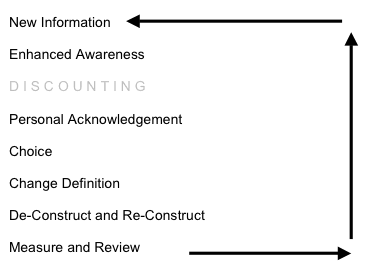the learning and change model
The learning and change model is an explanation of the process of learning and change and it can be used in a personal, team or organisational setting to assess progress and to alert us to the need to ensure that each stage of the model has been effectively, as opposed to efficiently, managed. We often use this model in repsponse to a client plea: 'Why won't my employees change?'
Working with teams and individuals, this model creates both insights and a language to break down internal, rarely stated barriers to change, progress and development.
Model
Our view is a simple one – if people were going to change on their own they would have probably done it by now.
If logic caused behavioural change then a simple email to a workforce would improve quality, increase productivity, shift culture and eliminate racism, sexism and all health and safety issues.
Logic then is not the key that it would seem or the tool that most managers wish that it were!

This model suggests that change begins with the provision of new information. This could come externally or internally as a result of seeing, hearing or feeling something.
New information always has the impact of creating enhanced awareness yet that awareness level increase can be hard to define in advance and even harder to predict. Two people may listen to the same message and hear different things. By the time that spreads out across an organisation you potentially have an uncontrollable virus running that sounds a little like the key message but has become corrupted or twisted.
There is a gap in the model after awareness because awareness on it's own rarely changes behaviour – if that were true there would be no-one in the world still smoking! The gap exists because there is a psychological phenomenon here called discounting that can undermine almost any message.
This gap in the model can allow any person off the hook of change – we all have pre-programmed and learned ways of responding to ensure that we don't 'hear' difficult messages. From smoking to parenting to leadership and beyond – this discounting area allows us to avoid the real impact of new information by denying that it applies to us. How else could intelligent people keep on putting tobacco in their mouths and lighting up?
If the message is powerful enough or the pain of staying in the same position is bad enough then discounting can be defeated and acknowledgment can take over. This is almost universally a physical reaction to enhanced awareness – it is usually a 'swallow' - the accepting of the information and awareness into the body – often accompanied by a 'shiver'.
I now accept that what I’m being told has an impact on me and I am now more likely to consider alternatives and question my original and learned position.
Making a positive choice to engage in change is not certain however. An individual may still choose to carry on with the old behaviours. This is most likely when the perceived discomfort of change is deemed to be greater that the actual discomfort of maintaining the status-quo. If the individual decides to move forward from this position then there is a real need to have the change definition established in order that I can be clear about what I am being asked to do differently.
Once defined, change is still tough because there will be things that individuals or those around me do and say that support and encourage the old way of doing things. The organisation my still have systems that support the old style.
So now we have to deconstruct those aspects of the infrastructure that support the old ways and we have to reconstruct new infrastructure, habits and processes that support the new, wanted behaviours. This is the aspect of change and transformation that most organisations and individuals fail to address - instead they attempt to bring in a new piece of behaviour that is 'unwelcome' within the infrastructure or culture.
If we're smart, we'll find non-invasive ways to measure and review our progress – the outputs of which become our next layer of new information and we can enter a phase of continuous improvement and leave behind the notion of regular change events.
